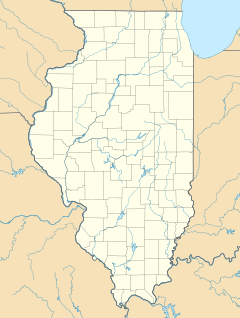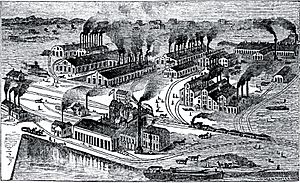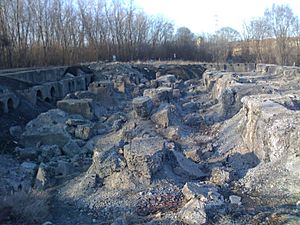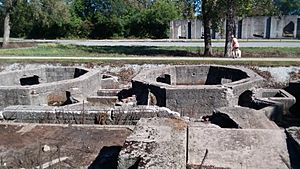Joliet Iron and Steel Works facts for kids
Quick facts for kids |
|
|
Joliet Steel Works
|
|
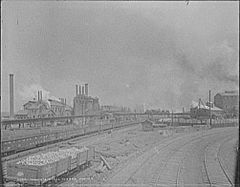
1901 photo of the steel works at Joliet
|
|
| Location | Joliet, Illinois |
|---|---|
| Nearest city | Chicago |
| NRHP reference No. | 91000088 |
| Added to NRHP | 1991-02-28 |
The Joliet Iron and Steel Works was a huge factory. It used to be the second largest steel mill in the entire United States. This important factory started making iron and steel in 1869. It kept working until 1936. Later, by the early 1980s, it became too expensive to run. So, all operations stopped.
In the 1990s, a group called the Forest Preserve District of Will County bought the land. They wanted to save this piece of history. Now, you can visit the site. It is called the Joliet Iron Works Historic Site.
Contents
The Story of Joliet Steel Works
The Joliet Iron and Steel Works began with the Joliet Iron and Steel Company. This company started the factory in 1869. Later, in 1889, a bigger company called the Illinois Steel Company took over. Even bigger changes happened after that. Illinois Steel became part of Federal Steel. This company was very important in forming U.S. Steel. U.S. Steel is one of the biggest steel companies ever.
A key part of the factory was the rolling mill. This machine made long pieces of metal. It started working in March 1873. The Joliet Works made many railroad tracks. These tracks helped America's railroads grow across the country.
How the Factory Worked
The factory used the Des Plaines River for power. It had a dam on the river. There were also four huge blast furnaces. These furnaces could make up to 2,000 tons of pig iron every day. Pig iron is a basic form of iron.
The factory had many other buildings too. These included a stock house and a casting house. There were also hot blast stoves and a gas washing plant. A blowing engine house and a gas engine house helped run the machinery.
Life for the Workers
Around the year 1900, about 2,000 people worked at Joliet Iron Works. Many workers came from Southern Europe and Eastern Europe. Their jobs were very dangerous. They faced toxic fumes and could fall from high places. The heat inside the factory was also extreme.
The workers at Joliet Works were part of a big event. This was the Steel Strike of 1919. Workers went on strike to ask for better conditions. By 1926, the Steel Works employed even more people, around 4,000 workers.
Visiting the Historic Site Today
Today, you can explore the remains of the Joliet Iron Works. There is a 1.5-mile (2.4 km) paved trail. This trail lets visitors see the old factory ruins. Along the path, signs explain how iron and steel were made. They also tell about the skills of the workers.
Next to the Iron Works is the Illinois and Michigan Canal. There is also a trail along the canal. This is the I & M Canal Trail.
The site is also a starting point for another trail. This is the 12.5-mile (20.1 km) I&M Canal Trail/Centennial Trail. Parts of this trail are paved, and some are crushed limestone. It connects downtown Joliet to the Centennial Trail in Cook County, Illinois.
The Joliet Iron Works Historic Site was updated in 2009 and 2010. Now, it has a picnic shelter for visitors. There are also restrooms and drinking water available.


